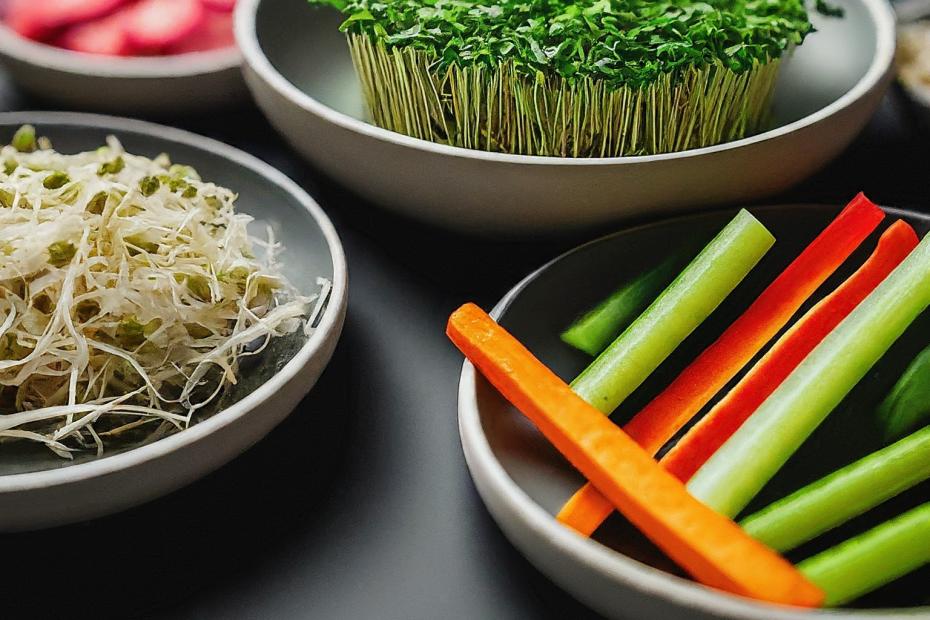When it comes to healthy eating, understanding the nutritional value of your food is key. Often, we reach for familiar vegetables, but the plant kingdom offers a wider range of options with unique benefits. Today we will be reviewing a nutritional comparison of microgreens, sprouts and vegetables. This article explores the distinct nutritional profiles of each option, discusses the pros and cons, and examines how they can elevate your diet.
Microgreens vs. Sprouts
| Sprouts | Microgreens | |
| Time to Harvest | 3- 5 days | 7-14 days |
| Length | Shorter at 2-3 inches | Generally longer being 4-7 inches |
| Growth Medium | Grown Hydroponically | Can be grown in either hydroponic media or soil |
| Physiological Appearance | Do not form the true leaves but only the seed leaves (cotyledon) | Form true leaves |
| How to eat | Whole sprout is eaten – seed, root, stem, and seed leaves | Only part above soil level is eaten – not the seed or root |
| Nutritional content | Less than microgreens | More than sprouts |
| Requirement for Light | Do not need light to grow (little to no photosynthesis) | Require light to grow |
| Ventilation while growing | Do not need air ventilation | Require good air ventilation |
| Recipes to include | Great for crunch and stir-fry | Great for soup, salad, garnish, sandwich, and various dishes |
| Varieties | Limited in choices | Well over 80 types to grow |
| Fiber content | Less than microgreens | More than sprouts |
| Cost to purchase | Cheaper than microgreens | More expensive than sprouts |
Which is better microgreens vs sprouts? – Microgreens are a better choice than sprouts due to their amazing flavors, higher concentrations of micronutrients, and lower risk of toxic bacteria growth. While sprouts may have more nutrition, microgreens still pack an incredible amount of nutrition compared to store-bought greens. Additionally, most people prefer the taste and texture of microgreens over sprouts. So, if you’re looking for a highly nutritious and flavorful superfood, microgreens are the way to go!
Are sprouts safer than microgreens? – Sprouts are not as safe as microgreens due to their growing conditions. Sprouts are grown in a humid and dark environment, making them more susceptible to bacterial growth. On the other hand, microgreens are grown in a soil-based environment with ventilation and sunlight. Additionally, microgreens have higher concentrations of micronutrients than sprouts. Therefore, microgreens are considered a safer and more nutritious option than sprouts.
Are microgreens just baby plants? – Contrary to popular belief, microgreens are not the same as sprouts and are actually baby plants that are packed with nutrients compared to their adult counterparts. Microgreens are grown in soil and take weeks to grow, unlike sprouts that do not need soil and grow when the seed begins to sprout. Microgreens require more ventilation and sunlight to reduce the chances of bacterial growth.
Are microgreens healthier than regular greens? – Microgreens are small plants that are harvested after the first true leaves appear. They are gaining popularity due to their nutritional value and unique taste. Research shows that microgreens have a higher concentration of vitamins, minerals, and antioxidants than mature greens. They also have more fiber content and are beneficial for heart health, blood sugar regulation, and skin health. Therefore, it can be concluded that microgreens are healthier than regular greens.
https://microveggy.com/sprouts-vs-microgreens
Microgreens vs. Vegetables
Mature vegetables, on the other hand, are the familiar garden or supermarket staples that have reached full maturity before harvest. These include common favorites like carrots, broccoli, spinach, and tomatoes. While they may not have the same nutritional concentration as microgreens, mature vegetables offer their own set of advantages:
1. Fiber Content: Mature vegetables are an excellent source of dietary fiber, which aids digestion, supports a feeling of fullness, and helps regulate blood sugar levels. Fiber also plays a key role in maintaining a healthy gut microbiome.
2. Long Shelf Life: Unlike microgreens, mature vegetables tend to have a longer shelf life, making them a practical choice for those who prefer to stock up on groceries less frequently. Their durability means you can store them for longer periods without spoilage.
3. Versatility: Mature vegetables are incredibly versatile in cooking. From hearty stews and stir-fries to raw salads and smoothies, they can be incorporated into a wide range of dishes. Their variety and adaptability make them a staple in countless culinary traditions worldwide.
4. Balanced Nutrient Profiles: While microgreens boast concentrated nutrients, mature vegetables provide a broader spectrum of vitamins, minerals, and phytonutrients. These nutrients work together to support overall health.
The Verdict: Balancing Both for Optimal Nutrition
So, which is better for you: microgreens or mature vegetables? The answer lies in finding a harmonious balance between the two. Each offers unique nutritional benefits that complement each other:
Microgreens as Nutrient Boosters: Incorporate microgreens into your diet to supercharge your nutrient intake. Toss them into salads, use them as garnishes for soups and main dishes, or blend them into smoothies. They can elevate the nutritional profile of your meals.
Mature Vegetables for Sustenance: Mature vegetables should remain a staple in your diet. They provide essential fiber, vitamins, and minerals that contribute to overall health. Use them as the foundation of your meals, incorporating a colorful array of vegetables in your daily menu.
https://liwli.com/microgreens-vs-mature-veggies-which-is-healthier/
A Nutritional Comparison of Microgreens, Sprouts and Vegetables
Vitamins and Minerals
- Microgreens: Contain significantly higher concentrations of vitamins (C, E, K) and minerals (iron, zinc, magnesium, potassium) compared to both sprouts and mature vegetables.
- Sprouts: Offer a moderate amount of vitamins (C, K) and minerals (iron, magnesium, phosphorus, calcium).
- Vegetables: Provide a substantial amount of vitamins (A, C, K) and minerals (potassium, magnesium, calcium), but generally at lower concentrations than microgreens.
Antioxidants
- Microgreens: Have the highest levels of antioxidants, making them particularly effective in protecting cells from damage.
- Sprouts: Contain a good amount of antioxidants, though less than microgreens.
- Vegetables: While still beneficial, have the lowest concentration of antioxidants compared to microgreens and sprouts.
Other Nutrients
- Microgreens: Highly nutrient-dense with a wide array of phytonutrients. They also provide a good amount of fiber and protein, making them a “superfood.”
- Sprouts: Offer beneficial enzymes that aid digestion, along with fiber and protein.
- Vegetables: High in dietary fiber, important for digestive health, and balanced in terms of nutrients.
Summary
- Microgreens are the standout option, boasting superior nutrient density. They provide the highest levels of vitamins, minerals, and antioxidants, making them the best choice for maximizing nutritional intake.
- Sprouts are a good middle ground, offering moderate levels of essential nutrients and beneficial enzymes that aid digestion.
- Vegetables are a staple in a balanced diet, providing a broad spectrum of nutrients and high fiber content, though at lower concentrations compared to microgreens.
In conclusion, while all three—sprouts, vegetables, and microgreens—are beneficial to your diet, microgreens are the most nutrient-dense option, delivering the highest concentrations of vitamins, minerals, and antioxidants.
Interested in getting some microgreens for yourself? Check out our online store and order our freeze dried Microgreen Nutri-Blend. It’s an affordable and convenient way to incorporate microgreens into your diet! We also offer fresh microgreens to our local customers. If you live in the Southern Oregon area, send us a message and sign up for a delivery of fresh, organic and delicious microgreens today!

